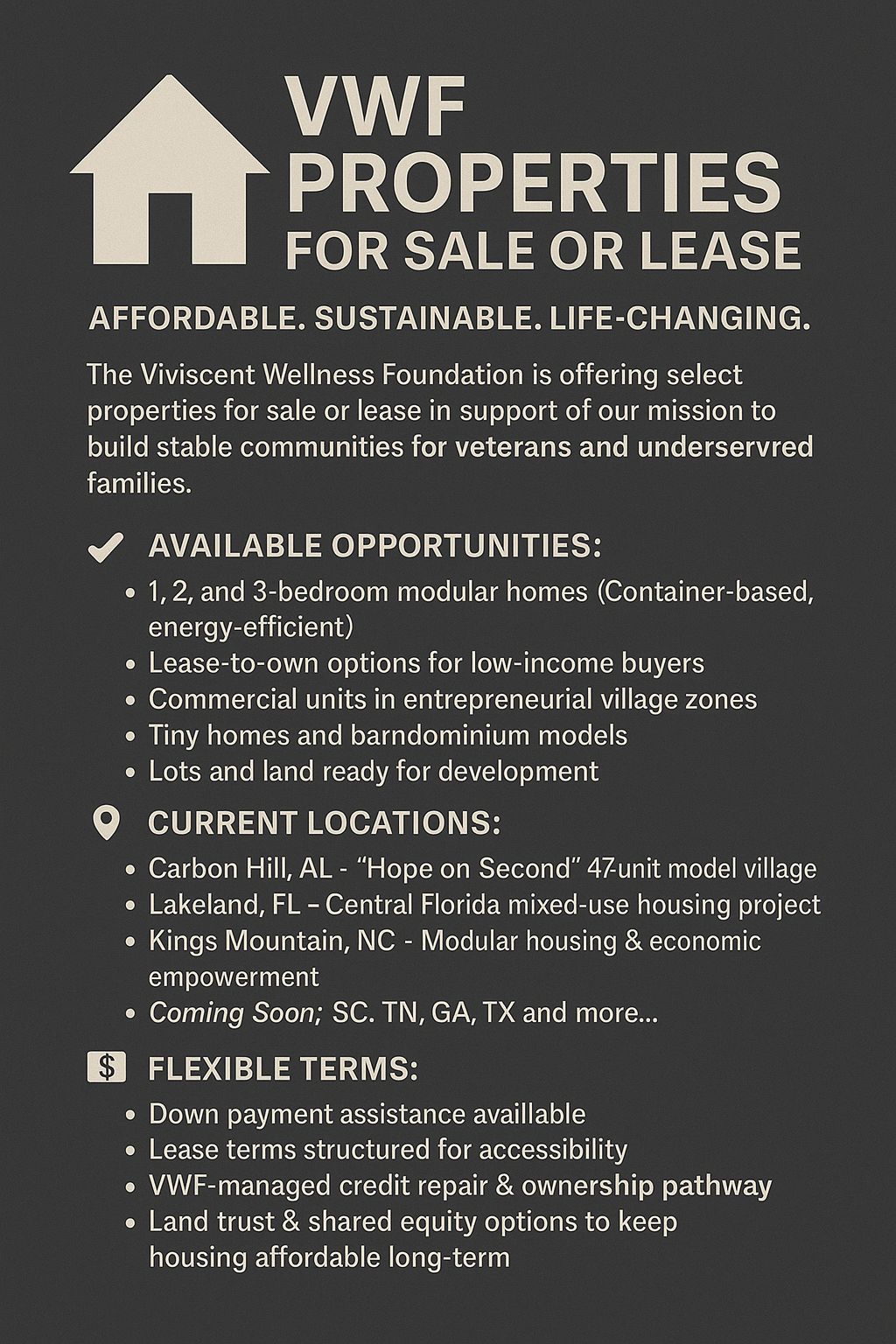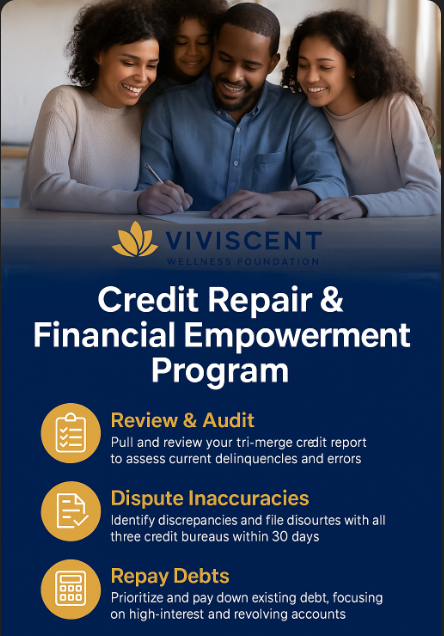Empower Your Financial Future
Rebuild. Restore. Rise Again.
Our 12-Step Credit Repair and Financial Wellness Program helps you rebuild your credit, increase your savings, and qualify for homeownership through the Viviscent Lease-to-Own Housing Pathway.
A World-Class Credit Restoration Program Built for Real People
This program was designed by financial professionals and nonprofit counselors to help everyday Americans achieve lasting financial freedom. Whether you’re rebuilding after hardship or preparing to buy your first home, our team walks beside you step-by-step through education, accountability, and real credit repair results.

Your 12-Step Journey to Financial Freedom
1
Review Your Credit
Begin by understanding your current credit status to identify areas for improvement.
2
Dispute Credit Errors
Challenge inaccuracies on your credit report to ensure accurate representation.
3
Repay Outstanding Debt
Create a strategic plan to address and reduce existing debt obligations.
Empower Your Financial Journey
Comprehensive Credit Analysis
Receive a detailed review of your credit report to identify areas for improvement.
Personalized Coaching Sessions
Work one-on-one with certified financial coaches to develop a tailored plan.
Access to Financial Tools
Utilize secured credit cards and credit-builder loans to boost your score.
Pathway to Homeownership
Qualify for our lease-to-own programs and take steps towards owning your home.

A world-class 12-Step Credit Restoration Program built for real people — empowering veterans and underserved families to rebuild, restore, and rise again.
Introduction
If you need assistance with repairing your credit scores, this guide outlines twelve key steps to help you decrease your debt-to-income ratio and rebuild your financial health. Your credit score is a vital number in your financial life — a three-digit figure between 350 and 850 that indicates how likely you are to repay debts.
Your credit scores are calculated based on the information in your reports from the three major credit bureaus — Equifax, Experian, and TransUnion. This number influences whether you can get approved for credit cards, loans, mortgages, apartments, and more. Lenders review your FICO® score in about 90% of credit decisions.
That’s why maintaining a healthy credit score is essential. If your credit is damaged, don’t panic — you can learn how to repair and rebuild it with time, strategy, and effort.
The 12 Steps to Repairing Your Credit
1. Review Your Credit Report
Obtain a copy of your credit report from all three major bureaus: Equifax, Experian, and TransUnion. You can get one free report every 12 months from each bureau by visiting AnnualCreditReport.com.
Review your reports carefully for errors and dispute any inaccuracies — even small mistakes can harm your score. Fixing these issues can substantially raise your credit score.
2. Challenge Inaccuracies in Your Credit Report
One in three people find errors on their credit reports. You can dispute and request removal of inaccurate information. File disputes online or by mail with each bureau, providing documentation. They must investigate within 30 days or remove the disputed items. Monitor your reports regularly to ensure no new negative entries appear.
3. Repay Your Debts
Your payment history accounts for 35% of your FICO® score. Repaying outstanding debts reduces your utilization ratio, which makes up 30%. Prioritize high-interest balances first and use methods like the Debt Avalanche or Debt Snowball to stay consistent.
4. Allow Time for Negative Entries to Be Removed
Negative marks like bankruptcies or late payments will eventually fall off. Focus on adding positive entries — consistent, on-time payments — so that when negatives expire, your score rebounds stronger.
5. Pay Your Bills on Time
Paying on time is the most critical factor in credit scoring. Set up autopay to avoid late payments. Even a single missed payment can undo months of progress. Always pay early when possible.
6. Keep Your Credit Utilization Low
Keep balances under 30% of your credit limits. If possible, pay off cards in full monthly. Low utilization demonstrates strong financial management and keeps your score healthy.
7. Maintain Open Credit Accounts
Keep older accounts open to extend your credit history, which makes up 15% of your score. Use small recurring charges and pay them off monthly to keep accounts active. Close only those with high annual fees.
8. Get a Secured Credit Card
A secured credit card requires a refundable deposit that becomes your credit limit. Responsibly using it helps build your credit history because payments are reported to all major bureaus.
9. Get a Credit Builder Loan
Credit builder loans hold your payments in a bank account and release them when the loan is repaid. On-time payments improve your history and demonstrate financial responsibility to future lenders.
10. Become an Authorized User
Ask a family member or friend with good credit to add you as an authorized user on their card. Their positive payment history is added to your file, improving your score. Be responsible — don’t use their credit unless you can pay it back promptly.
11. Use Nontraditional Credit Reporting
Services like Experian Boost or rent-reporting programs can add on-time utility and rent payments to your credit profile, building a positive history.
12. Only Obtain Credit When Necessary
Each credit application creates a hard inquiry that may lower your score a few points. Limit new applications and space them out to preserve your credit age and strength.
Maintaining an Ideal Credit Score
Credit reporting agencies calculate your score based on several weighted factors: payment history (35%), utilization (30%), credit history length (15%), new credit inquiries (10%), and credit mix (10%).
Always pay on time, keep balances low, and avoid unnecessary credit applications. A long and positive credit history is your best asset.
FICO Score Ranges
300 – 579: Poor — considered high risk; likely to face denials or higher fees.
580 – 669: Fair — approved with higher interest rates or lower limits.
670 – 734: Good — meets most lender requirements with competitive rates.
740 – 799: Very Good — approved for nearly all credit with excellent terms.
800 – 850: Exceptional — qualifies for the best interest rates and highest loan amounts.
The higher your credit score, the better offers you’ll receive. Even small improvements can save you thousands over the life of a loan.
The Viviscent Wellness Foundation’s Credit Repair & Financial Empowerment Program offers step-by-step coaching, education, and accountability to help you reach your financial goals. We work with veterans, families, and individuals ready to take control of their credit and build a foundation for lasting success.
Begin today by joining the program and scheduling your financial coaching session.
Step 1
Step 1: Complete the Intake Form
Start your journey by filling out our online credit intake form.
Step 2
Step 2: Schedule a Coaching Call
Book a session with a financial coach to discuss your personalized roadmap.
Step 3
Step 3: Receive Your Credit Roadmap
Within seven days, get a customized plan to improve your credit score.
Step 4
Step 4: Track Your Progress
Use our monthly dashboard to monitor your credit improvements.
“Thanks to Viviscent, I improved my credit score by 150 points and am now a proud homeowner!”

Emily
First-Time Homebuyer
“The coaching sessions were invaluable. I now have a solid financial plan and a new home.”

James
Veteran
“From struggling with debt to owning a home, Viviscent changed my life.”

Sophia
Single Mother
“I never thought homeownership was possible until I joined this program.”

Michael
Young Professional

